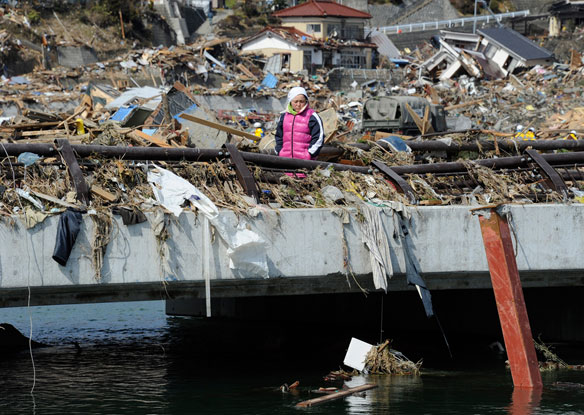By Ryan Nakashima and Mari Yamaguchi, Associated Press
Engineers pinned their hopes on chemicals, sawdust and shredded newspaper to stop highly radioactive water pouring into the ocean from Japan’s tsunami-ravaged nuclear plant Sunday as officials said it will take several months to bring the crisis under control, the first time they have provided a timetable.
Concrete already failed to stop the tainted water spewing from a crack in a maintenance pit, and the new mixture did not appear to be working either, but engineers said they were not abandoning it.
The Fukushima Da-ichi plant has been leaking radioactivity since the March 11 tsunami carved a path of destruction along Japan’s northeastern coast, killing as many as 25,000 people and knocking out key cooling systems that kept it from overheating. People living within 12 miles (20 kilometers) of the plant have been forced to abandon their homes.
The government said Sunday it will be several months before the radiation stops and permanent cooling systems are restored. Even after that happens, there will be years of work ahead to clean up the area around the complex and figure out what to do with it.
“It would take a few months until we finally get things under control and have a better idea about the future,” said Nuclear and Industrial Safety Agency spokesman Hidehiko Nishiyama. “We’ll face a crucial turning point within the next few months, but that is not the end.”
His agency said the timetable is based on the first step, pumping radioactive water into tanks, being completed quickly and the second, restoring cooling systems, being done within a matter of weeks or months.
Every day brings some new problem at the plant, where workers have often been forced to retreat from repair efforts because of high radiation levels. On Sunday, plant operator Tokyo Electric Power Co. announced it had found the bodies of two workers missing since the tsunami.
Radiation, debris and explosions kept workers from finding them until Wednesday, and then the announcement was delayed several days out of respect for their families.
TEPCO officials said they believed the workers ran down to a basement to check equipment after the magnitude-9.0 earthquake that preceded the tsunami. They were there when the massive wave swept over the plant.
“It pains us to have lost these two young workers who were trying to protect the power plant amid the earthquake and tsunami,” TEPCO Chairman Tsunehisa Katsumata said in a statement.
On Saturday, workers discovered an 8-inch (20-centimeter) crack in a maintenance pit at the plant and said they believe water from it may be the source of some of the high levels of radioactive iodine that have been found in the ocean for more than a week.
This is the first time they have found radioactive water leaking directly into the sea. A picture released by TEPCO shows water shooting some distance away from a wall and splashing into the ocean, though the amount is not clear. No other cracks have been found.
The radioactive water dissipates quickly in the ocean but could be dangerous to workers at the plant.
Engineers tried to seal the crack with concrete Saturday, but that effort failed.
So on Sunday they went farther up the system and injected sawdust, three garbage bags of shredded newspaper and a polymer, similar to one used to absorb liquid in diapers, that can expand to 50 times its normal size when combined with water.
The polymer mix in the passageway leading to the pit had not stopped the leak by Sunday night, but it also had not leaked out of the crack along with the water, so engineers were stirring it in an attempt to get it to expand. They expected to know by Monday morning if it would work.
Meanwhile, tens of thousands of people are still living in shelters, 200,000 households do not have water, and 170,000 do not have electricity.
Running water was just restored in the port city of Kesennuma on Saturday, and residents lined up Sunday to see a dentist who had flown in from the country’s far north to offer his services. Many were elderly and complaining of problems with their dentures.
Overhead and throughout the coastal region, helicopters and planes roared by as U.S. and Japanese forces finished their all-out search for bodies.
The effort, which ended Sunday, is probably the final hope for retrieving the dead, though limited operations may continue. It has turned up nearly 50 bodies in the past two days.
In all, more than 12,000 deaths have been confirmed, and another 15,500 people are missing.
Efforts to Plug Japanese Reactor Leak Seem to Fail
Experts estimate that about seven tons an hour of radioactive water is escaping the pit. The water contains one million becquerels per liter of iodine 131, or about 10,000 times the levels normally found in water at a nuclear plant.










